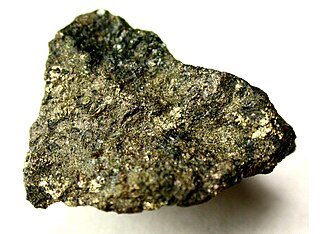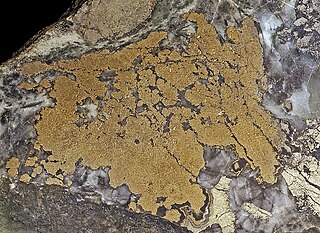Related Research Articles

Pentlandite is an iron–nickel sulfide with the chemical formula (Fe,Ni)9S8. Pentlandite has a narrow variation range in nickel to iron ratios (Ni:Fe), but it is usually described as 1:1. In some cases, this ratio is skewed by the presence of pyrrhotite inclusions. It also contains minor cobalt, usually at low levels as a fraction of weight.

Nickeline or niccolite is a mineral consisting primarily of nickel arsenide (NiAs). The naturally-occurring mineral contains roughly 43.9% nickel and 56.1% arsenic by mass, but composition of the mineral may vary slightly.

Ultramafic rocks are igneous and meta-igneous rocks with a very low silica content, generally >18% MgO, high FeO, low potassium, and are composed of usually greater than 90% mafic minerals. The Earth's mantle is composed of ultramafic rocks. Ultrabasic is a more inclusive term that includes igneous rocks with low silica content that may not be extremely enriched in Fe and Mg, such as carbonatites and ultrapotassic igneous rocks.

Komatiite is a type of ultramafic mantle-derived volcanic rock defined as having crystallised from a lava of at least 18 wt% magnesium oxide (MgO). It is classified as a 'picritic rock'. Komatiites have low silicon, potassium and aluminium, and high to extremely high magnesium content. Komatiite was named for its type locality along the Komati River in South Africa, and frequently displays spinifex texture composed of large dendritic plates of olivine and pyroxene.
Jasperoid is a rare, peculiar type of metasomatic alteration and occurs in two main forms; sulfidic jasperoids and hematitic jasperoids. True jasperoids are different from jaspillite, which is a form of metamorphosed chemical sedimentary rock, and from jasper which is a chemical sediment.

The Yilgarn Craton is a large craton that constitutes a major part of the Western Australian land mass. It is bounded by a mixture of sedimentary basins and Proterozoic fold and thrust belts. Zircon grains in the Jack Hills, Narryer Terrane have been dated at ~4.27 Ga, with one detrital zircon dated as old as 4.4 Ga.
Kambalda type komatiitic nickel ore deposits are a class of magmatic iron-nickel-copper-platinum-group element ore deposit in which the physical processes of komatiite volcanology serve to deposit, concentrate and enrich a Fe-Ni-Cu-(PGE) sulfide melt within the lava flow environment of an erupting komatiite volcano.
The Emily Ann and Maggie Hays nickel deposits are situated 117 km west of the town of Norseman, Western Australia, within the Lake Johnston Greenstone Belt.

Gaspéite, a very rare nickel carbonate mineral, with the formula (Ni,Fe,Mg)CO3, is named for the place it was first described, in the Gaspé Peninsula, Québec, Canada.

Kambaldaite, NaNi4(CO3)3(OH)3·3H2O, is an extremely rare hydrated sodium nickel carbonate mineral described from gossanous material associated with Kambalda type komatiitic nickel ore deposits at Kambalda, Western Australia, and Widgie Townsite nickel gossan, Widgiemooltha, Western Australia.
Violarite (Fe2+Ni23+S4) is a supergene sulfide mineral associated with the weathering and oxidation of primary pentlandite nickel sulfide ore minerals.
Anthony James "Tony" Naldrett, FRSC was an English and Canadian geologist. He was an authority on the geology and origin of nickel-copper-platinum group element deposits, the tectonic setting in which they occur, the petrology of associated rocks, and controls on their composition. He was an expert on the reaction between sulfide and silicate melts, fractional crystallization of sulfide melts, and the role of hydrothermal fluids.

Creighton Mine is an underground nickel, copper, and platinum-group elements (PGE) mine. It is presently owned and operated by Vale Limited in the city of Greater Sudbury, Ontario, Canada. Open pit mining began in 1901, and underground mining began in 1906. The mine is situated in the Sudbury Igneous Complex (SIC) in its South Range geologic unit. The mine is the source of many excavation-related seismic events, such as earthquakes and rock burst events. It is home to SNOLAB, and is currently the deepest nickel mine in Canada. Expansion projects to deepen the Creighton Mine are currently underway.

The Broken Hill Ore Deposit is located underneath Broken Hill in western New South Wales, Australia, and is the namesake for the town. It is arguably the world's richest and largest zinc-lead ore deposit.

The Temagami Greenstone Belt (TGB) is a small 2.7 billion year old greenstone belt in the Temagami region of Northeastern Ontario, Canada. It represents a feature of the Superior craton, an ancient and stable part of the Earth's lithosphere that forms the core of the North American continent and Canadian Shield. The belt is composed of metamorphosed volcanic rocks that range in composition from basalt to rhyolite. These form the east-northeast trend of the belt and are overlain by metamorphosed sedimentary rocks. They were created during several volcanic episodes involving a variety of eruptive styles ranging from passive lava eruptions to viscous explosive eruptions.
Carl Michael Lesher is an American geologist. He is an authority on the geology and origin of nickel-copper-platinum group element deposits, especially those associated with komatiites, their physical volcanology and localization, the geochemistry and petrology of associated rocks, and controls on their composition.

A nickel mine is a mine that produces nickel. Some mines produce nickel primarily, while some mines produce nickel as a side-product of some other metal that has a higher concentration in the ore.

Nickel mining in Western Australia has been an industry that has had many fluctuations of fortune in its history. Large fluctuations in the world nickel price have seen mines close and reopen on several occasions.

Millerite or nickel blende is a nickel sulfide mineral, NiS. It is brassy in colour and has an acicular habit, often forming radiating masses and furry aggregates. It can be distinguished from pentlandite by crystal habit, its duller colour, and general lack of association with pyrite or pyrrhotite.

Kambalda Nickel Operations or Kambalda Nickel Mine is a surface and underground nickel mine as well as a nickel concentrator, near Kambalda East, Western Australia. The deposit was discovered in 1954 and the mine opened in 1967, operated by WMC Resources which was taken over by BHP in 2005. Prior to this, between 2001 and 2003, WMC ceased mining operations at Kambalda and divested itself of the mining assets.
References
This article includes a list of references, related reading, or external links, but its sources remain unclear because it lacks inline citations .(February 2008) |
- Clarke, J. D. A. (1991). The geology of the 132N nickel deposit (Report). Vol. 198. Western Mining Corporation.
- Hill, R. I.; Compston, W. (1986). Age of granite emplacement, southeastern Yilgarn Block, Western Australia (Report). Australian National University Research School of Earth Sciences. pp. 70–71.
- Hill, R. E. T.; Barnes, S. J.; Gole, M. J.; Dowling, S. E. (1990). Physical volcanology of komatiites; A field guide to the komatiites of the Norseman-Wiluna Greenstone Belt, Eastern Goldfields Province, Yilgarn Block, Western Australia. Geological Society of Australia. ISBN 0-909869-55-3.
- McQueen, K. G. (October 1981). "Volcanic-associated nickel deposits from around the Widgiemooltha Dome, Western Australia". Economic Geology. 76 (6): 1417–1443. Bibcode:1981EcGeo..76.1417M. doi:10.2113/gsecongeo.76.6.1417.
- Marston, R. J.; Groves, D. I.; Hudson, D. R.; Ross, J. R. (October 1981). "Nickel sulfide deposits in Western Australia: a review". Economic Geology. 76 (6): 1330–1363. Bibcode:1981EcGeo..76.1330M. doi:10.2113/gsecongeo.76.6.1330.
- Nickel, E. H.; Clout, J. F. M.; Gartrell, B. J. (July 1994). "Secondary nickel minerals from Widgiemooltha". Mineralogical Record. 25 (4): 283–291. ProQuest 211708719.
- Nickel, E. H.; Robinson, B. W.; Mumme, W. G. (August 1993). "Widgiemoolthalite: The new Ni analogue of hydromagnesite from Western Australia" (PDF). American Mineralogist. 78 (7–8): 819–821.
- Woodall, R.; Travis, G. A. (1969). "The Kambalda nickel deposits, Western Australia". In Jones, M. J. (ed.). Proceedings of the 9th Commonwealth Mining and Metallurgical Congress. Vol. 2. London: The Institution of Mining and Metallurgy. pp. 517–533.